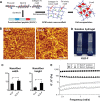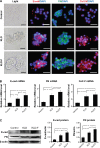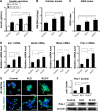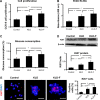Functionalized self-assembling peptide improves INS-1 β-cell function and proliferation via the integrin/FAK/ERK/cyclin pathway
- PMID: 25999715
- PMCID: PMC4436204
- DOI: 10.2147/IJN.S80502
Functionalized self-assembling peptide improves INS-1 β-cell function and proliferation via the integrin/FAK/ERK/cyclin pathway
Abstract
Islet transplantation is considered to be a curative treatment for type 1 diabetes mellitus. However, disruption of the extracellular matrix (ECM) leads to β-cell destruction and graft dysfunction. In this study, we developed a functionalized self-assembling peptide, KLD-F, with ECM mimic motifs derived from fibronectin and collagen IV, and evaluated its effect on β-cell function and proliferation. Atomic force microscopy and rheological results showed that KLD-F could self-assemble into a nanofibrous scaffold and change into a hydrogel in physiological saline condition. In a three-dimensional cell culture model, KLD-F improved ECM remodeling and cell-cell adhesion of INS-1 β-cells by upregulation of E-cadherin, fibronectin, and collagen IV. KLD-F also enhanced glucose-stimulated insulin secretion and expression of β-cell function genes, including Glut2, Ins1, MafA, and Pdx-1 in INS-1 cells. Moreover, KLD-F promoted proliferation of INS-1 β-cells and upregulated Ki67 expression by mediating cell cycle progression. In addition, KLD-F improved β-cell function and proliferation via an integrin/focal adhesion kinase/extracellular signal-regulated kinase/cyclin D pathway. This study highlights the fact that the β-cell-ECM interaction reestablished with this functionalized self-assembling peptide is a promising method to improve the therapeutic efficacy of islet transplantation.
Keywords: extracellular matrix; insulin secretion; islet transplantation; self-assembling peptide; β-cell proliferation.
Figures






Similar articles
-
Fibrin improves beta (INS-1) cell function, proliferation and survival through integrin αvβ3.Acta Biomater. 2013 Sep;9(9):8140-8. doi: 10.1016/j.actbio.2013.05.035. Epub 2013 Jun 7. Acta Biomater. 2013. PMID: 23747317
-
Novel mechanistic link between focal adhesion remodeling and glucose-stimulated insulin secretion.J Biol Chem. 2012 Jan 20;287(4):2423-36. doi: 10.1074/jbc.M111.279885. Epub 2011 Dec 2. J Biol Chem. 2012. PMID: 22139838 Free PMC article.
-
Atrial natriuretic peptide promotes pancreatic islet beta-cell growth and Akt/Foxo1a/cyclin D2 signaling.Endocrinology. 2009 Dec;150(12):5455-65. doi: 10.1210/en.2009-0468. Epub 2009 Oct 16. Endocrinology. 2009. PMID: 19837876
-
Role and impact of the extracellular matrix on integrin-mediated pancreatic β-cell functions.Biol Cell. 2017 Jun;109(6):223-237. doi: 10.1111/boc.201600076. Epub 2017 Apr 18. Biol Cell. 2017. PMID: 28266044 Review.
-
β1-Integrin-A Key Player in Controlling Pancreatic Beta-Cell Insulin Secretion via Interplay With SNARE Proteins.Endocrinology. 2022 Nov 14;164(1):bqac179. doi: 10.1210/endocr/bqac179. Endocrinology. 2022. PMID: 36282882 Review.
Cited by
-
Self-Assembling Peptides as an Emerging Platform for the Treatment of Metabolic Syndrome.Int J Nanomedicine. 2020 Dec 21;15:10349-10370. doi: 10.2147/IJN.S278189. eCollection 2020. Int J Nanomedicine. 2020. PMID: 33376325 Free PMC article. Review.
-
Engineering a Self-Assembling Leucine Zipper Hydrogel System with Function-Specific Motifs for Tissue Regeneration.ACS Biomater Sci Eng. 2020 May 11;6(5):2913-2928. doi: 10.1021/acsbiomaterials.0c00026. Epub 2020 Apr 7. ACS Biomater Sci Eng. 2020. PMID: 33463282 Free PMC article.
-
Simultaneous Recruitment of Stem Cells and Chondrocytes Induced by a Functionalized Self-Assembling Peptide Hydrogel Improves Endogenous Cartilage Regeneration.Front Cell Dev Biol. 2020 Aug 27;8:864. doi: 10.3389/fcell.2020.00864. eCollection 2020. Front Cell Dev Biol. 2020. PMID: 33015049 Free PMC article.
-
Towards rational computational peptide design.Front Bioinform. 2022 Oct 21;2:1046493. doi: 10.3389/fbinf.2022.1046493. eCollection 2022. Front Bioinform. 2022. PMID: 36338806 Free PMC article.
-
Engineered M13 Nanofiber Accelerates Ischemic Neovascularization by Enhancing Endothelial Progenitor Cells.Tissue Eng Regen Med. 2017 Aug 28;14(6):787-802. doi: 10.1007/s13770-017-0074-x. eCollection 2017 Dec. Tissue Eng Regen Med. 2017. PMID: 30603528 Free PMC article.
References
-
- American Diabetes Association Diagnosis and classification of diabetes mellitus. Diabetes Care. 2008;S1:S55–S60. - PubMed
-
- Brownlee M. The pathobiology of diabetic complications: a unifying mechanism. Diabetes. 2005;54:1615–1625. - PubMed
-
- Liu J, Wang D, Chen Y, et al. 1H NMR-based metabonomic analysis of serum and urine in a nonhuman primate model of diabetic nephropathy. Mol Biosyst. 2013;9:2645–2652. - PubMed
-
- Korsgren O, Lundgren T, Felldin M, et al. Optimising islet engraftment is critical for successful clinical islet transplantation. Diabetologia. 2008;51:227–232. - PubMed
Publication types
MeSH terms
Substances
LinkOut - more resources
Full Text Sources
Miscellaneous

